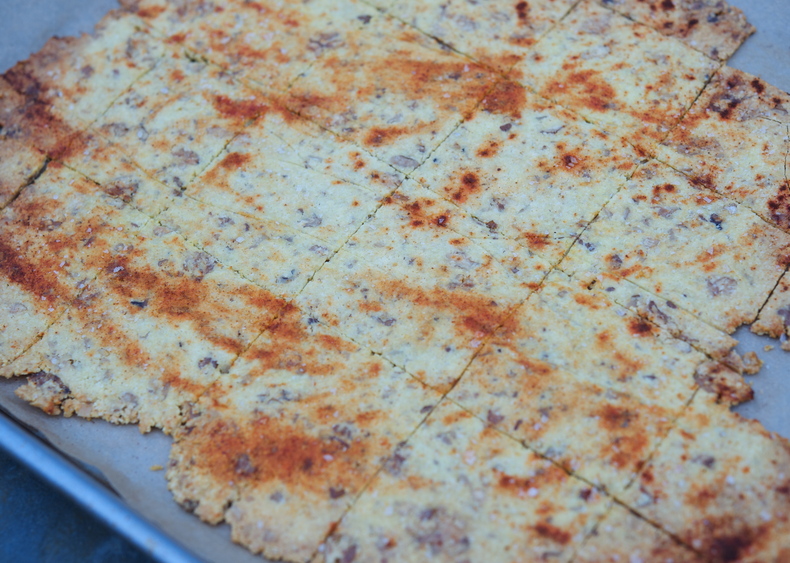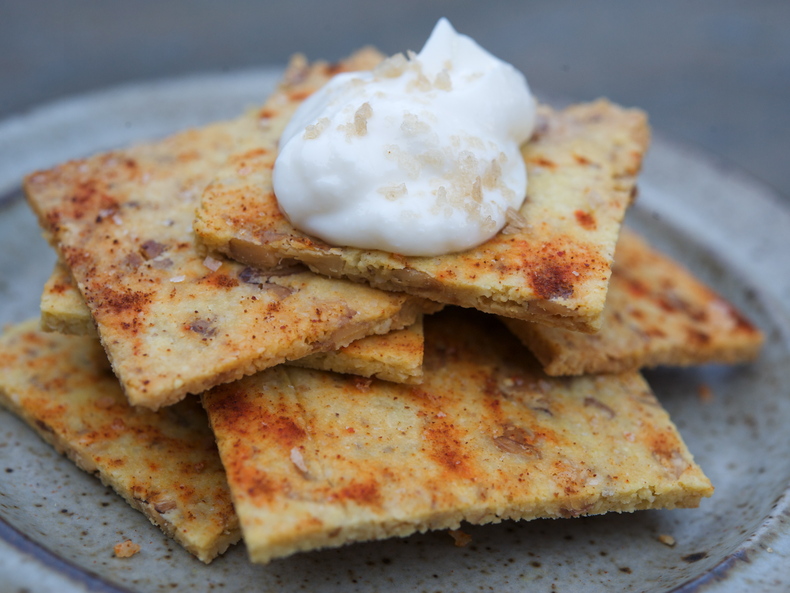5.21.10 Wafer Thin
As I've mentioned before, ours is a gluten-free household. This does not mean we don't LOVE bread but G, my husband, was diagnosed as "gluten intolerant" a couple of years ago and tries his best to eat accordingly. (I support him in this, and feel it has done me a world of good as well.) Gluten is the gluey, stretchy stuff that gives products made from wheat, rye and barley their wonderfully meaty chew. Sadly, for celiacs and people with gluten intolerance, this is the same stuff that irritates the villi—microscopic finger-like projections that line the inner wall of the small intestine and aid in the absorption of food. In learning about this condition, I've come across a lot of information to indicate that refined highly processed flours are not so good for any of us. (I believe I already told you that my nutritionist, Sally Kravich, equates eating white flour with smearing your colon with that paste we used to make in elementary school.) The rise of inflammatory diseases like arthritis, colitis, IBS and even tooth decay is directly associated with the rise of agriculture and industry. Just try cutting out grains and starches from your diet for even 2 weeks to see how your aches and pains diminish. It's pretty amazing. But didn't our ancestors manage just fine eating grains, you ask? Actually, their approach to grains and baking was quite different from ours. Virtually all preindustrialized people soaked or fermented their grains before making them into porridge or bread or cake. Think how Indians ferment rice or lentils before making idlis and dosas; or how American pioneers made their breads and pancakes with sourdough starter. Way back when, instructions on the box of oatmeal even called for an overnight soak. Here's the science behind it (with thanks to Nourishing Traditions for breaking it down so intelligibly).
Unfortunately, the answer is not simply to eat whole grains. You see, when we split them into bran, germ and naked starch; when we mill them at high temperatures; when we extrude them to make crunchy breakfast cereals; and when we consume them without careful preparation, grains are no longer our friends.This is because they contain antinutrients that can cause serious health problems. When untreated, phytic acid—found in the bran or outer hull of seeds—can combine with calcium, magnesium, copper, iron and especially zinc in the intestinal tract and block their absorption. So a diet high in improperly prepared whole grains can lead to serious mineral deficiencies and bone loss. The misguided modern practice of consuming large amounts of unprocessed bran often improves colon transit time at first but may eventually lead to irritable bowel syndrome and, in the long term, many other adverse effects.Whole grains also contains enzyme inhibitors which can inhibit digestion and put stress on the pancreas; irritating tannins; complex sugars which the body cannot break down; and gluten and related hard-to-digest proteins which often cause allergies, digestive disorders and even mental illness.WTF?! you say. Why would nature do this? Well, most of these antinutrients are part of the seed's system of preservation—they prevent sprouting until the conditions are right. Plants need moisture, warmth, time and slight acidity in order to sprout. Preparing grains the right way imitates the process that occurs in nature. It involves soaking for a period in warm, acidulated water in the preparation of porridge, or long, slow sour dough fermentation in the making of bread. Such processes neutralize phytic acid and enzyme inhibitors. Vitamin content increases, particularly B vitamins. Tannins, complex sugars, gluten and other difficult-to-digest substances are partially broken down into simpler components that are more readily available for absorption.Consider animals that nourish themselves primarily on grain and other plant matter. They have as many as four stomachs to do the job! Their intestines are longer, as is the entire digestion transit time. Man, on the other hand, has just one stomach and a much shorter intestine compared to herbivorous animals. These features of our anatomy allow us to pass animal products before they putrefy in the gut—but make us much less well adapted to a diet high in grains—unless, of course, we prepare them properly. When grains are properly prepared through soaking, sprouting or sour leavening, the friendly bacteria of the microscopic world do some of our digesting for us in a container, just as these same lactobacilli do their work in the first and second stomachs of the herbivores.Sadly, modern technology has turned our bread—even our whole grain bread—into a poison. Grains are laced with pesticides during the growing season and in storage; they are milled at high temperatures so that their fatty acids turn rancid. Rancidity increases when milled flours are stored for long periods of time, particularly in open bins. The bran and germ are often removed and sold separately, when Mother Nature intended that they be eaten together with the carbohydrate portion; they're baked as quick rise breads so that antinutrients remain; synthetic vitamins and an unabsorbable form of iron added to white flour can cause numerous imbalances; dough conditioners, stabilizers, preservatives and other additives add insult to injury.Cruelty to grains in the making of breakfast cereals is intense. Slurries of grain are forced through tiny holes at high temperatures and pressures in giant extruders, a process that destroys nutrients and turns the proteins in grains into veritable poisons. Westerners pay a lot for expensive breakfast cereals that snap, crackle and pop, including the rising toll of poor health. DON'T FEED PREPACKAGED CEREALS OF ANY SORT TO YOUR KIDS!The final indignity to grains is that we treat them as loners, largely ignorant of other dietary factors needed for the nutrients they provide. Fat-soluble vitamins A and D found in animal fats like butter, lard and cream help us absorb calcium, phosphorus, iron, B vitamins and the many other vitamins that grains provide. Porridge eaten with cream will do us a thousand times more good than cold breakfast cereal consumed with skim milk; sourdough whole grain bread with butter or whole cheese is a combination that contributes to optimal health.It's a lot to take in, right? I will teach you—as I go along learning myself—how to sprout grains and make sourdoughs. In the meantime, look for organic, stone ground, sprouted or sour dough whole grain breads and enjoy them with butter or cheese. I mean, how hard is that really? Afraid of getting fat? Cut your sugar intake WAY down (that means booze, too), let go of the diet sodas and the vegetables oils, and watch your body balance itself.As for alternatives to wheat, discover red rice, wehani brown rice, quinoa and amaranth. (More on these later.) I've also learned how to substitute nut flours in delicious cakes like this one, or this one. (Of course, soaking the nuts first, then drying them and making your own flour in the food processor is best!) Overwhelmed? Try these delicious crackers made with almond flour and walnuts. Rolled out thin right on the baking sheet, they crisp up and are a wonderful foil for patés, cheeses and dips. Not a grain in sight, yet a perfectly viable cracker to munch on as you skip down the road to radiant health.

ALMOND-FLOUR CRACKERS3 cups blanched almond flour1½ teaspoons sea salt1 cup walnuts, chopped2 eggs, whisked until frothy1 tablespoon olive oil1 tablespoon crème fraichepimentón, spicy or mildsea salt for sprinklingPreheat oven to 350 degrees.Line two large baking sheets with parchment paper.In a large mixing bowl, stir together almond flour, salt, walnuts, eggs, oil and crème fraiche until well blended. Roll into a big ball.Separate ball of dough into equal parts and place a half in the center of each baking sheet. Cut another piece of parchment paper the size of the baking sheet and place it over one of the balls of dough. Roll the dough out between the two pieces of parchment paper, until it is about ⅛” thick and covers as much of the baking sheet as possible. Remove the top sheet and repeat process with the other piece of dough.Sprinkle both sheets of dough with sea salt and any pimentón, or any spices you like. A mix of seeds (sesame, poppy, celery, etc) would also be nice. Score the dough with a knife or pizza cutter into 2” squares (or whatever size you want).Bake 12 minutes, until golden brown. Cool and serve.







4 Comments